Pharmacology Assignment 1: B Adrenergic Receptors and Heart Diseases
VerifiedAdded on 2020/03/28
|12
|2940
|78
Report
AI Summary
This report provides a comprehensive analysis of the clinical implications of B adrenergic receptors, with a specific focus on their significance in the context of heart diseases. The report begins with an abstract that introduces pharmacogenomics and the role of beta 1 adrenergic receptors in cardiac tissues. It then delves into the common polymorphisms in adrenergic receptors, particularly the substitution of arginine to lysine at position 16, and its impact on heart function. The introduction highlights the signaling genes of B adrenergic receptors, their polymorphic nature, and their contribution to the diagnosis and treatment of heart diseases. The report explores specific polymorphisms like Arg389Gly in ADRB1 and Arg16Gly and Glu27Gln in ADRB2, and their varying prevalence across different populations. Furthermore, the report examines the B1 adrenergic receptors' role in heart diseases, their influence on heart rate, contraction, and renin release, and their connection to hypertension and cardiovascular effects. The report also discusses the impact of B1 receptors on heart muscle contraction, the clinical outcomes of B1 receptor mediation in heart diseases, and the use of B1 adrenergic blockers in cardiac therapy. It also explores the relationship between B1 adrenergic receptors and high blood pressure and obesity, and concludes with a discussion on the clinical pharmacology of B1 adrenergic receptors and their impact on heart function.

Running head: PHARMACOLOGY ASSIGNMENT 1
Pharmacology assignment
Student’s Name
Date of Submission
Pharmacology assignment
Student’s Name
Date of Submission
Paraphrase This Document
Need a fresh take? Get an instant paraphrase of this document with our AI Paraphraser
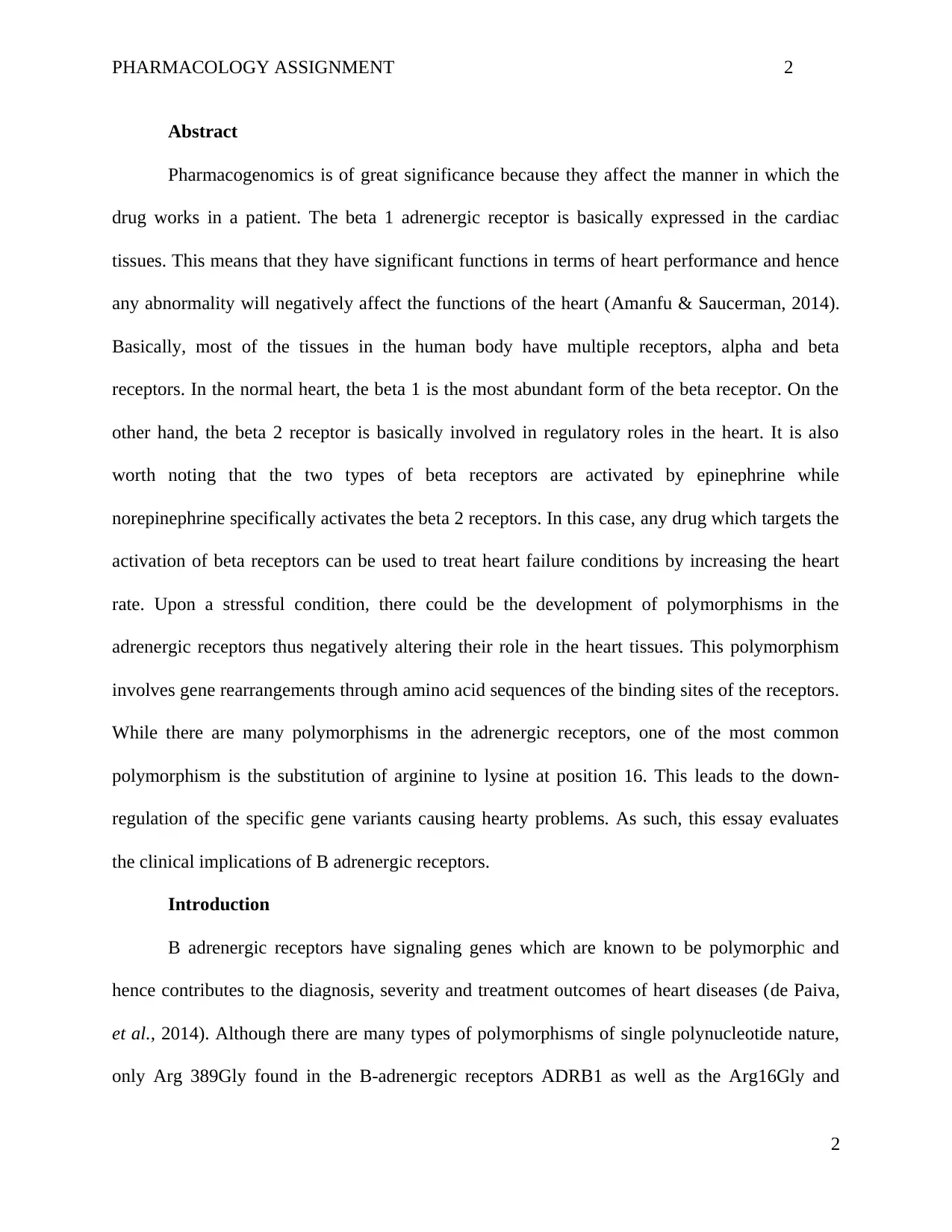
PHARMACOLOGY ASSIGNMENT 2
Abstract
Pharmacogenomics is of great significance because they affect the manner in which the
drug works in a patient. The beta 1 adrenergic receptor is basically expressed in the cardiac
tissues. This means that they have significant functions in terms of heart performance and hence
any abnormality will negatively affect the functions of the heart (Amanfu & Saucerman, 2014).
Basically, most of the tissues in the human body have multiple receptors, alpha and beta
receptors. In the normal heart, the beta 1 is the most abundant form of the beta receptor. On the
other hand, the beta 2 receptor is basically involved in regulatory roles in the heart. It is also
worth noting that the two types of beta receptors are activated by epinephrine while
norepinephrine specifically activates the beta 2 receptors. In this case, any drug which targets the
activation of beta receptors can be used to treat heart failure conditions by increasing the heart
rate. Upon a stressful condition, there could be the development of polymorphisms in the
adrenergic receptors thus negatively altering their role in the heart tissues. This polymorphism
involves gene rearrangements through amino acid sequences of the binding sites of the receptors.
While there are many polymorphisms in the adrenergic receptors, one of the most common
polymorphism is the substitution of arginine to lysine at position 16. This leads to the down-
regulation of the specific gene variants causing hearty problems. As such, this essay evaluates
the clinical implications of B adrenergic receptors.
Introduction
B adrenergic receptors have signaling genes which are known to be polymorphic and
hence contributes to the diagnosis, severity and treatment outcomes of heart diseases (de Paiva,
et al., 2014). Although there are many types of polymorphisms of single polynucleotide nature,
only Arg 389Gly found in the B-adrenergic receptors ADRB1 as well as the Arg16Gly and
2
Abstract
Pharmacogenomics is of great significance because they affect the manner in which the
drug works in a patient. The beta 1 adrenergic receptor is basically expressed in the cardiac
tissues. This means that they have significant functions in terms of heart performance and hence
any abnormality will negatively affect the functions of the heart (Amanfu & Saucerman, 2014).
Basically, most of the tissues in the human body have multiple receptors, alpha and beta
receptors. In the normal heart, the beta 1 is the most abundant form of the beta receptor. On the
other hand, the beta 2 receptor is basically involved in regulatory roles in the heart. It is also
worth noting that the two types of beta receptors are activated by epinephrine while
norepinephrine specifically activates the beta 2 receptors. In this case, any drug which targets the
activation of beta receptors can be used to treat heart failure conditions by increasing the heart
rate. Upon a stressful condition, there could be the development of polymorphisms in the
adrenergic receptors thus negatively altering their role in the heart tissues. This polymorphism
involves gene rearrangements through amino acid sequences of the binding sites of the receptors.
While there are many polymorphisms in the adrenergic receptors, one of the most common
polymorphism is the substitution of arginine to lysine at position 16. This leads to the down-
regulation of the specific gene variants causing hearty problems. As such, this essay evaluates
the clinical implications of B adrenergic receptors.
Introduction
B adrenergic receptors have signaling genes which are known to be polymorphic and
hence contributes to the diagnosis, severity and treatment outcomes of heart diseases (de Paiva,
et al., 2014). Although there are many types of polymorphisms of single polynucleotide nature,
only Arg 389Gly found in the B-adrenergic receptors ADRB1 as well as the Arg16Gly and
2
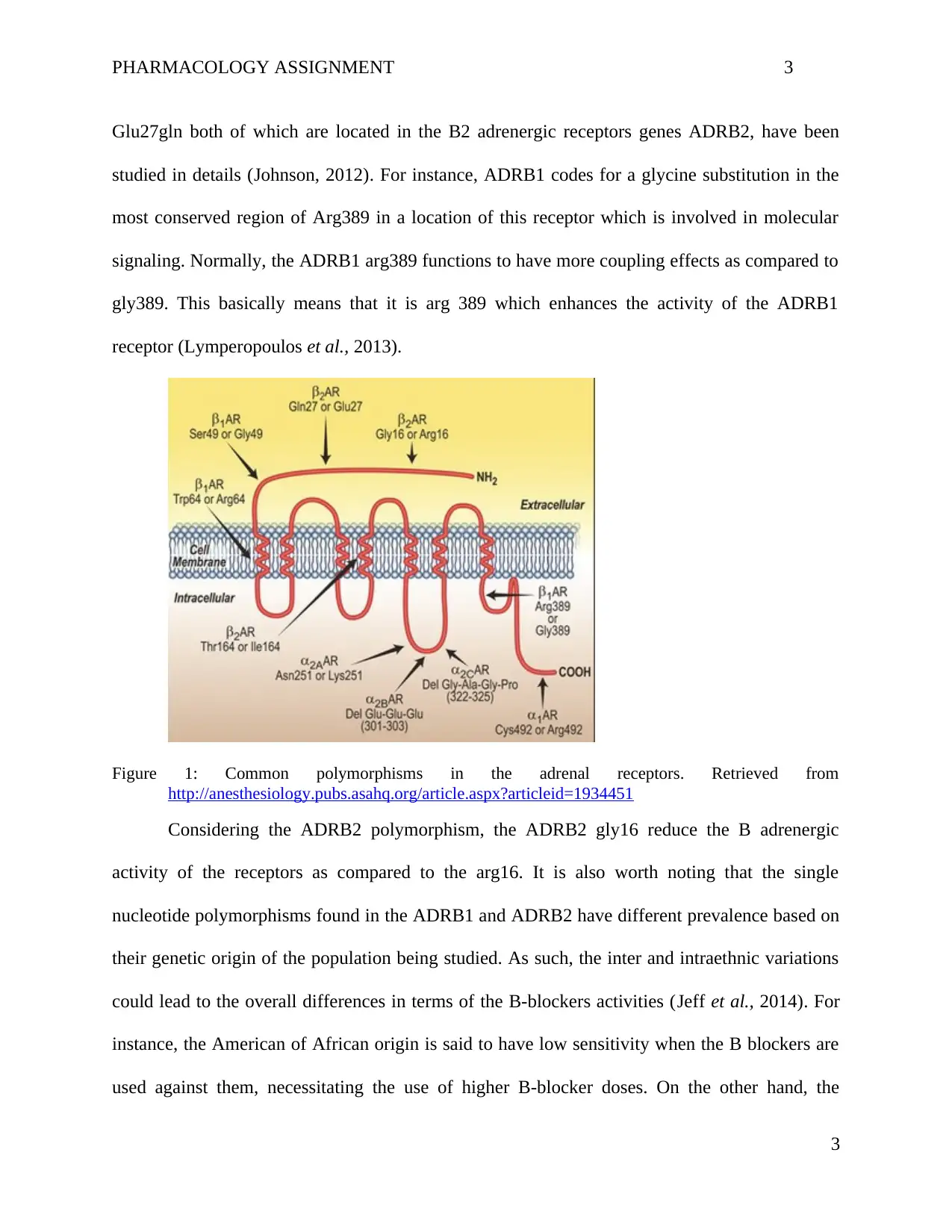
PHARMACOLOGY ASSIGNMENT 3
Glu27gln both of which are located in the B2 adrenergic receptors genes ADRB2, have been
studied in details (Johnson, 2012). For instance, ADRB1 codes for a glycine substitution in the
most conserved region of Arg389 in a location of this receptor which is involved in molecular
signaling. Normally, the ADRB1 arg389 functions to have more coupling effects as compared to
gly389. This basically means that it is arg 389 which enhances the activity of the ADRB1
receptor (Lymperopoulos et al., 2013).
Figure 1: Common polymorphisms in the adrenal receptors. Retrieved from
http://anesthesiology.pubs.asahq.org/article.aspx?articleid=1934451
Considering the ADRB2 polymorphism, the ADRB2 gly16 reduce the B adrenergic
activity of the receptors as compared to the arg16. It is also worth noting that the single
nucleotide polymorphisms found in the ADRB1 and ADRB2 have different prevalence based on
their genetic origin of the population being studied. As such, the inter and intraethnic variations
could lead to the overall differences in terms of the B-blockers activities (Jeff et al., 2014). For
instance, the American of African origin is said to have low sensitivity when the B blockers are
used against them, necessitating the use of higher B-blocker doses. On the other hand, the
3
Glu27gln both of which are located in the B2 adrenergic receptors genes ADRB2, have been
studied in details (Johnson, 2012). For instance, ADRB1 codes for a glycine substitution in the
most conserved region of Arg389 in a location of this receptor which is involved in molecular
signaling. Normally, the ADRB1 arg389 functions to have more coupling effects as compared to
gly389. This basically means that it is arg 389 which enhances the activity of the ADRB1
receptor (Lymperopoulos et al., 2013).
Figure 1: Common polymorphisms in the adrenal receptors. Retrieved from
http://anesthesiology.pubs.asahq.org/article.aspx?articleid=1934451
Considering the ADRB2 polymorphism, the ADRB2 gly16 reduce the B adrenergic
activity of the receptors as compared to the arg16. It is also worth noting that the single
nucleotide polymorphisms found in the ADRB1 and ADRB2 have different prevalence based on
their genetic origin of the population being studied. As such, the inter and intraethnic variations
could lead to the overall differences in terms of the B-blockers activities (Jeff et al., 2014). For
instance, the American of African origin is said to have low sensitivity when the B blockers are
used against them, necessitating the use of higher B-blocker doses. On the other hand, the
3
⊘ This is a preview!⊘
Do you want full access?
Subscribe today to unlock all pages.

Trusted by 1+ million students worldwide
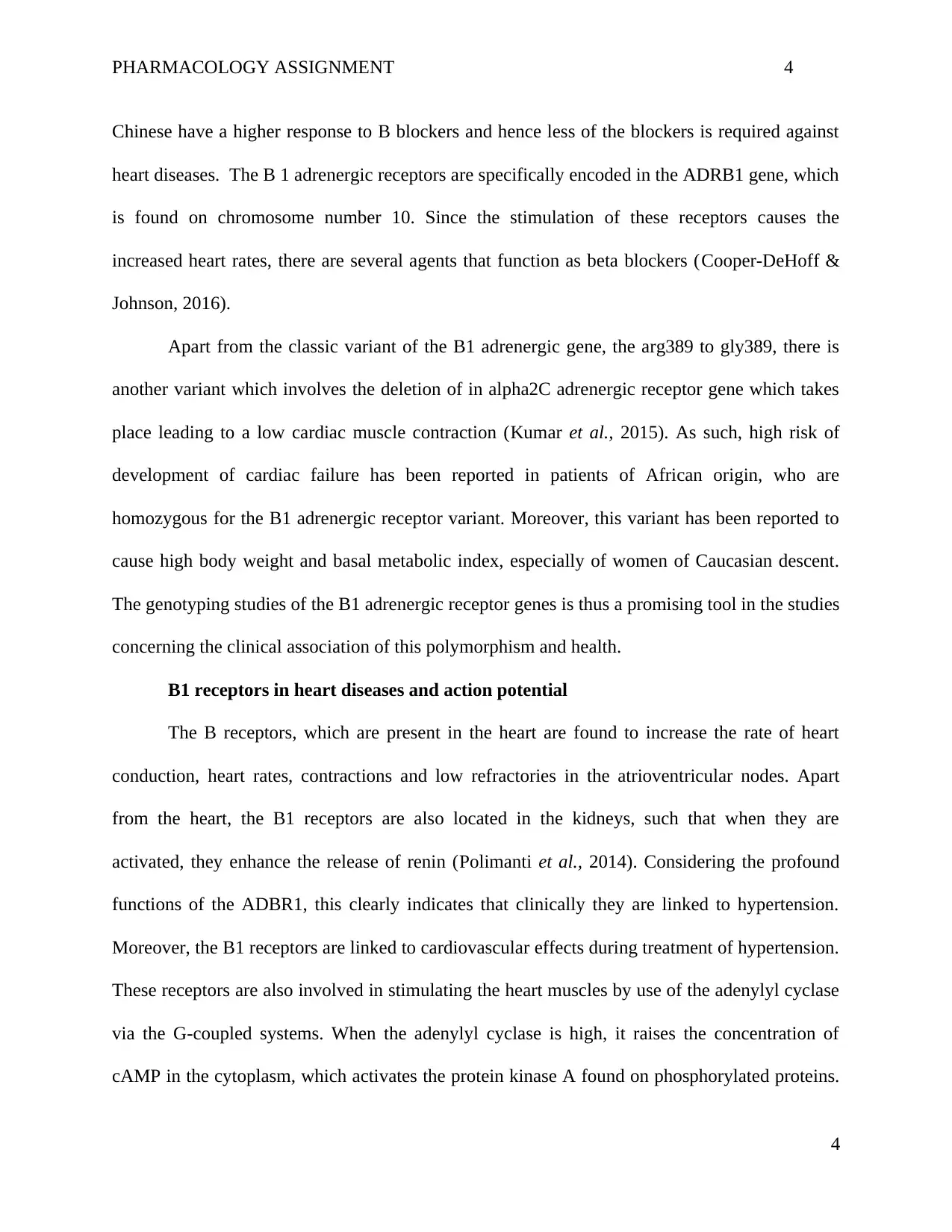
PHARMACOLOGY ASSIGNMENT 4
Chinese have a higher response to B blockers and hence less of the blockers is required against
heart diseases. The B 1 adrenergic receptors are specifically encoded in the ADRB1 gene, which
is found on chromosome number 10. Since the stimulation of these receptors causes the
increased heart rates, there are several agents that function as beta blockers (Cooper-DeHoff &
Johnson, 2016).
Apart from the classic variant of the B1 adrenergic gene, the arg389 to gly389, there is
another variant which involves the deletion of in alpha2C adrenergic receptor gene which takes
place leading to a low cardiac muscle contraction (Kumar et al., 2015). As such, high risk of
development of cardiac failure has been reported in patients of African origin, who are
homozygous for the B1 adrenergic receptor variant. Moreover, this variant has been reported to
cause high body weight and basal metabolic index, especially of women of Caucasian descent.
The genotyping studies of the B1 adrenergic receptor genes is thus a promising tool in the studies
concerning the clinical association of this polymorphism and health.
B1 receptors in heart diseases and action potential
The B receptors, which are present in the heart are found to increase the rate of heart
conduction, heart rates, contractions and low refractories in the atrioventricular nodes. Apart
from the heart, the B1 receptors are also located in the kidneys, such that when they are
activated, they enhance the release of renin (Polimanti et al., 2014). Considering the profound
functions of the ADBR1, this clearly indicates that clinically they are linked to hypertension.
Moreover, the B1 receptors are linked to cardiovascular effects during treatment of hypertension.
These receptors are also involved in stimulating the heart muscles by use of the adenylyl cyclase
via the G-coupled systems. When the adenylyl cyclase is high, it raises the concentration of
cAMP in the cytoplasm, which activates the protein kinase A found on phosphorylated proteins.
4
Chinese have a higher response to B blockers and hence less of the blockers is required against
heart diseases. The B 1 adrenergic receptors are specifically encoded in the ADRB1 gene, which
is found on chromosome number 10. Since the stimulation of these receptors causes the
increased heart rates, there are several agents that function as beta blockers (Cooper-DeHoff &
Johnson, 2016).
Apart from the classic variant of the B1 adrenergic gene, the arg389 to gly389, there is
another variant which involves the deletion of in alpha2C adrenergic receptor gene which takes
place leading to a low cardiac muscle contraction (Kumar et al., 2015). As such, high risk of
development of cardiac failure has been reported in patients of African origin, who are
homozygous for the B1 adrenergic receptor variant. Moreover, this variant has been reported to
cause high body weight and basal metabolic index, especially of women of Caucasian descent.
The genotyping studies of the B1 adrenergic receptor genes is thus a promising tool in the studies
concerning the clinical association of this polymorphism and health.
B1 receptors in heart diseases and action potential
The B receptors, which are present in the heart are found to increase the rate of heart
conduction, heart rates, contractions and low refractories in the atrioventricular nodes. Apart
from the heart, the B1 receptors are also located in the kidneys, such that when they are
activated, they enhance the release of renin (Polimanti et al., 2014). Considering the profound
functions of the ADBR1, this clearly indicates that clinically they are linked to hypertension.
Moreover, the B1 receptors are linked to cardiovascular effects during treatment of hypertension.
These receptors are also involved in stimulating the heart muscles by use of the adenylyl cyclase
via the G-coupled systems. When the adenylyl cyclase is high, it raises the concentration of
cAMP in the cytoplasm, which activates the protein kinase A found on phosphorylated proteins.
4
Paraphrase This Document
Need a fresh take? Get an instant paraphrase of this document with our AI Paraphraser

PHARMACOLOGY ASSIGNMENT 5
The B1 adrenergic agonist produces multiple effects in the cardiovascular system (Zanolla et al.,
2016). For instance, through the chronotropic effects, the sinoatrial nodes are able to increase the
heart rates. The b1 adrenergic receptors also produce positive ionotropic effects, that is, they
increase the strength of heart muscles during blood pumping.
Figure 2: Other B1 adrenergic polymorphisms. Retrieved from http://www.scielo.br/scielo.php?
pid=S0066-782X2010000600019&script=sci_arttext&tlng=en
The activation of the skeletal muscles is purely aimed at achieving a full activation of the
actomyosin through changes in the concentrations of calcium ions which are found in high
amounts in the SR. likewise in the heart muscles, the regulation, and control of the extent and
strength of contraction is sided by changes in the amount of calcium ions (Aleong et al., 2013).
Calcium ions originate from two major sources which are the cell membrane influx and the
intracellular stores of the SR. The full cardiac muscle contraction thus occurs in this fashion: that
when there is a high influx of calcium ions, the actomyosin bridges increase thus raising the
strength of heart muscle contractions. The stimulation of B1 adrenergic receptors levels of
5
The B1 adrenergic agonist produces multiple effects in the cardiovascular system (Zanolla et al.,
2016). For instance, through the chronotropic effects, the sinoatrial nodes are able to increase the
heart rates. The b1 adrenergic receptors also produce positive ionotropic effects, that is, they
increase the strength of heart muscles during blood pumping.
Figure 2: Other B1 adrenergic polymorphisms. Retrieved from http://www.scielo.br/scielo.php?
pid=S0066-782X2010000600019&script=sci_arttext&tlng=en
The activation of the skeletal muscles is purely aimed at achieving a full activation of the
actomyosin through changes in the concentrations of calcium ions which are found in high
amounts in the SR. likewise in the heart muscles, the regulation, and control of the extent and
strength of contraction is sided by changes in the amount of calcium ions (Aleong et al., 2013).
Calcium ions originate from two major sources which are the cell membrane influx and the
intracellular stores of the SR. The full cardiac muscle contraction thus occurs in this fashion: that
when there is a high influx of calcium ions, the actomyosin bridges increase thus raising the
strength of heart muscle contractions. The stimulation of B1 adrenergic receptors levels of
5
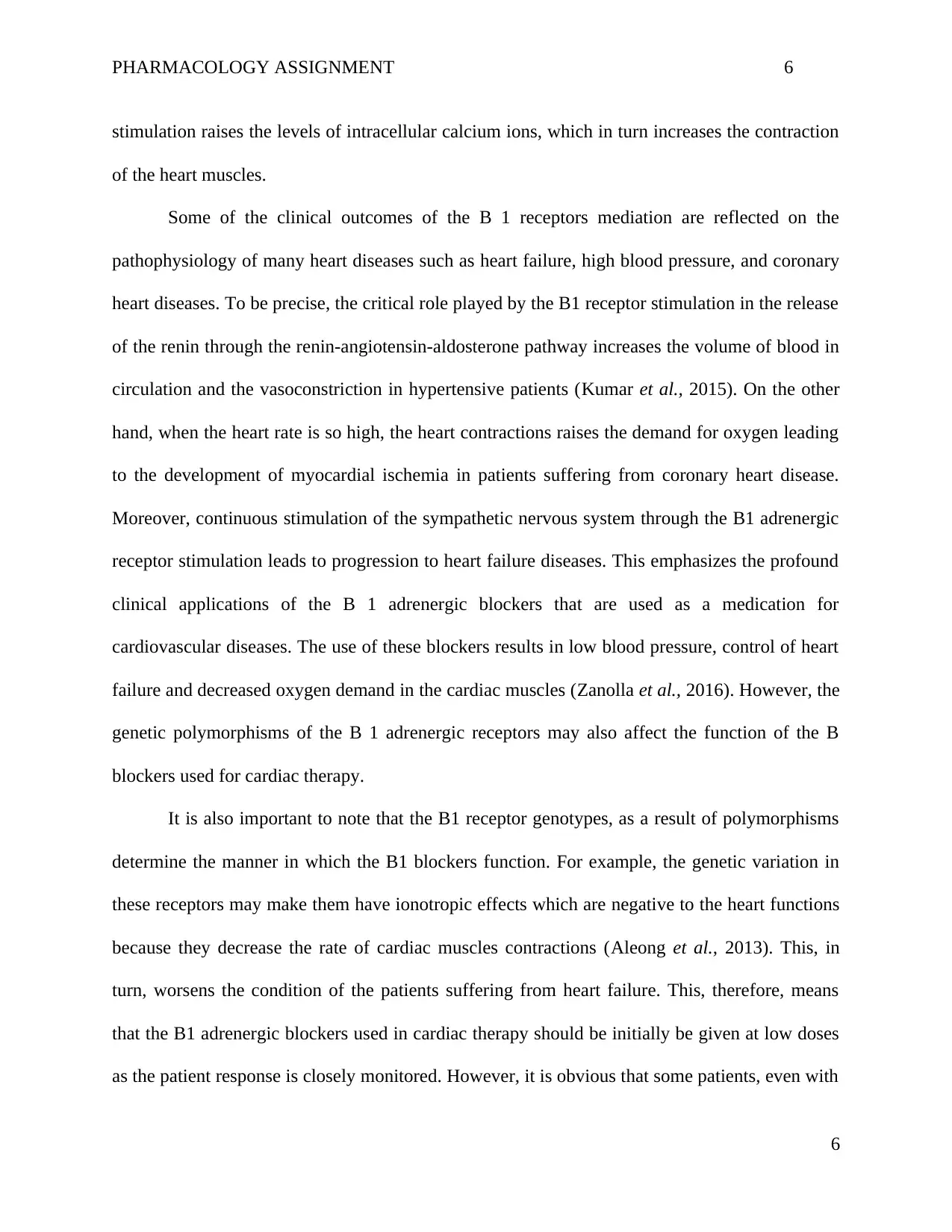
PHARMACOLOGY ASSIGNMENT 6
stimulation raises the levels of intracellular calcium ions, which in turn increases the contraction
of the heart muscles.
Some of the clinical outcomes of the B 1 receptors mediation are reflected on the
pathophysiology of many heart diseases such as heart failure, high blood pressure, and coronary
heart diseases. To be precise, the critical role played by the B1 receptor stimulation in the release
of the renin through the renin-angiotensin-aldosterone pathway increases the volume of blood in
circulation and the vasoconstriction in hypertensive patients (Kumar et al., 2015). On the other
hand, when the heart rate is so high, the heart contractions raises the demand for oxygen leading
to the development of myocardial ischemia in patients suffering from coronary heart disease.
Moreover, continuous stimulation of the sympathetic nervous system through the B1 adrenergic
receptor stimulation leads to progression to heart failure diseases. This emphasizes the profound
clinical applications of the B 1 adrenergic blockers that are used as a medication for
cardiovascular diseases. The use of these blockers results in low blood pressure, control of heart
failure and decreased oxygen demand in the cardiac muscles (Zanolla et al., 2016). However, the
genetic polymorphisms of the B 1 adrenergic receptors may also affect the function of the B
blockers used for cardiac therapy.
It is also important to note that the B1 receptor genotypes, as a result of polymorphisms
determine the manner in which the B1 blockers function. For example, the genetic variation in
these receptors may make them have ionotropic effects which are negative to the heart functions
because they decrease the rate of cardiac muscles contractions (Aleong et al., 2013). This, in
turn, worsens the condition of the patients suffering from heart failure. This, therefore, means
that the B1 adrenergic blockers used in cardiac therapy should be initially be given at low doses
as the patient response is closely monitored. However, it is obvious that some patients, even with
6
stimulation raises the levels of intracellular calcium ions, which in turn increases the contraction
of the heart muscles.
Some of the clinical outcomes of the B 1 receptors mediation are reflected on the
pathophysiology of many heart diseases such as heart failure, high blood pressure, and coronary
heart diseases. To be precise, the critical role played by the B1 receptor stimulation in the release
of the renin through the renin-angiotensin-aldosterone pathway increases the volume of blood in
circulation and the vasoconstriction in hypertensive patients (Kumar et al., 2015). On the other
hand, when the heart rate is so high, the heart contractions raises the demand for oxygen leading
to the development of myocardial ischemia in patients suffering from coronary heart disease.
Moreover, continuous stimulation of the sympathetic nervous system through the B1 adrenergic
receptor stimulation leads to progression to heart failure diseases. This emphasizes the profound
clinical applications of the B 1 adrenergic blockers that are used as a medication for
cardiovascular diseases. The use of these blockers results in low blood pressure, control of heart
failure and decreased oxygen demand in the cardiac muscles (Zanolla et al., 2016). However, the
genetic polymorphisms of the B 1 adrenergic receptors may also affect the function of the B
blockers used for cardiac therapy.
It is also important to note that the B1 receptor genotypes, as a result of polymorphisms
determine the manner in which the B1 blockers function. For example, the genetic variation in
these receptors may make them have ionotropic effects which are negative to the heart functions
because they decrease the rate of cardiac muscles contractions (Aleong et al., 2013). This, in
turn, worsens the condition of the patients suffering from heart failure. This, therefore, means
that the B1 adrenergic blockers used in cardiac therapy should be initially be given at low doses
as the patient response is closely monitored. However, it is obvious that some patients, even with
6
⊘ This is a preview!⊘
Do you want full access?
Subscribe today to unlock all pages.

Trusted by 1+ million students worldwide
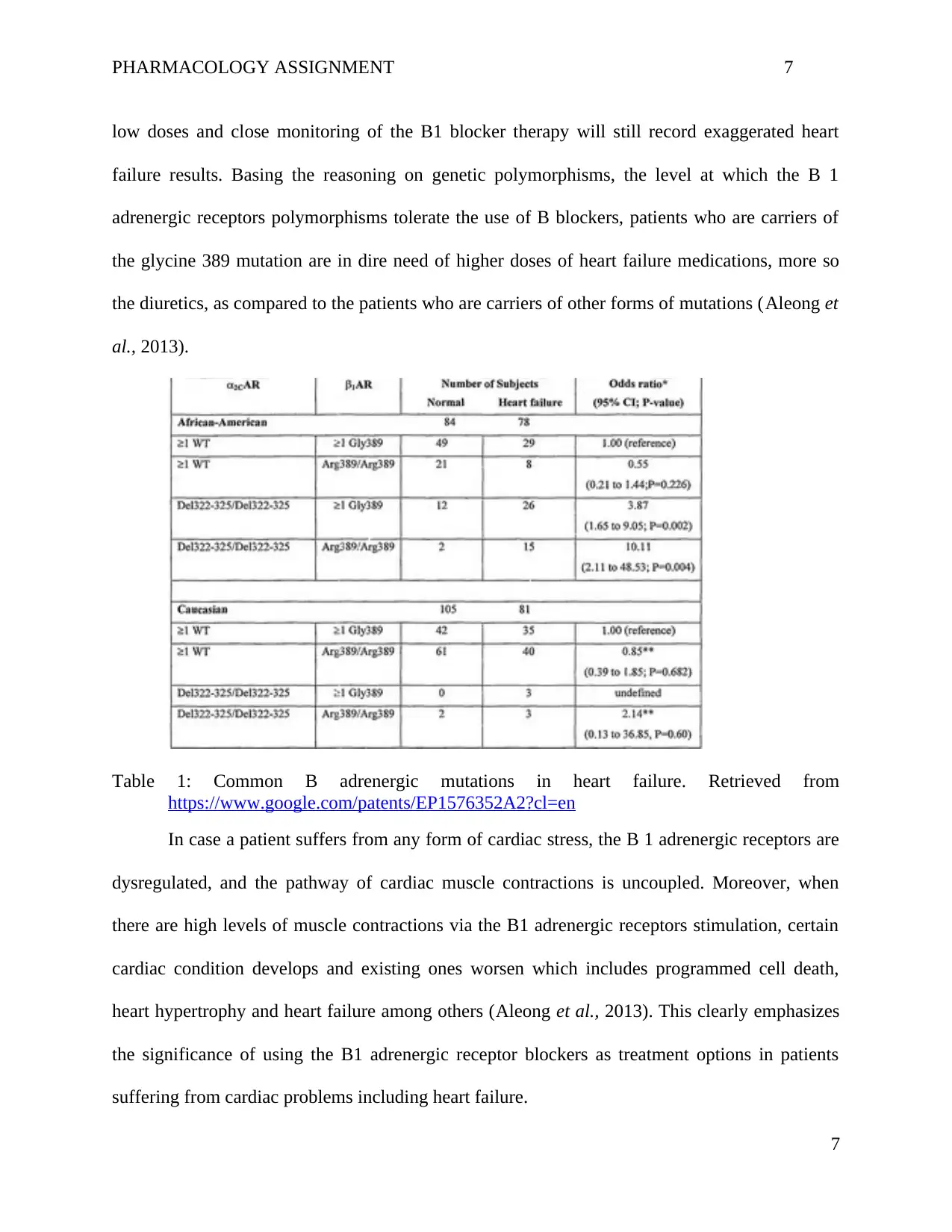
PHARMACOLOGY ASSIGNMENT 7
low doses and close monitoring of the B1 blocker therapy will still record exaggerated heart
failure results. Basing the reasoning on genetic polymorphisms, the level at which the B 1
adrenergic receptors polymorphisms tolerate the use of B blockers, patients who are carriers of
the glycine 389 mutation are in dire need of higher doses of heart failure medications, more so
the diuretics, as compared to the patients who are carriers of other forms of mutations (Aleong et
al., 2013).
Table 1: Common B adrenergic mutations in heart failure. Retrieved from
https://www.google.com/patents/EP1576352A2?cl=en
In case a patient suffers from any form of cardiac stress, the B 1 adrenergic receptors are
dysregulated, and the pathway of cardiac muscle contractions is uncoupled. Moreover, when
there are high levels of muscle contractions via the B1 adrenergic receptors stimulation, certain
cardiac condition develops and existing ones worsen which includes programmed cell death,
heart hypertrophy and heart failure among others (Aleong et al., 2013). This clearly emphasizes
the significance of using the B1 adrenergic receptor blockers as treatment options in patients
suffering from cardiac problems including heart failure.
7
low doses and close monitoring of the B1 blocker therapy will still record exaggerated heart
failure results. Basing the reasoning on genetic polymorphisms, the level at which the B 1
adrenergic receptors polymorphisms tolerate the use of B blockers, patients who are carriers of
the glycine 389 mutation are in dire need of higher doses of heart failure medications, more so
the diuretics, as compared to the patients who are carriers of other forms of mutations (Aleong et
al., 2013).
Table 1: Common B adrenergic mutations in heart failure. Retrieved from
https://www.google.com/patents/EP1576352A2?cl=en
In case a patient suffers from any form of cardiac stress, the B 1 adrenergic receptors are
dysregulated, and the pathway of cardiac muscle contractions is uncoupled. Moreover, when
there are high levels of muscle contractions via the B1 adrenergic receptors stimulation, certain
cardiac condition develops and existing ones worsen which includes programmed cell death,
heart hypertrophy and heart failure among others (Aleong et al., 2013). This clearly emphasizes
the significance of using the B1 adrenergic receptor blockers as treatment options in patients
suffering from cardiac problems including heart failure.
7
Paraphrase This Document
Need a fresh take? Get an instant paraphrase of this document with our AI Paraphraser
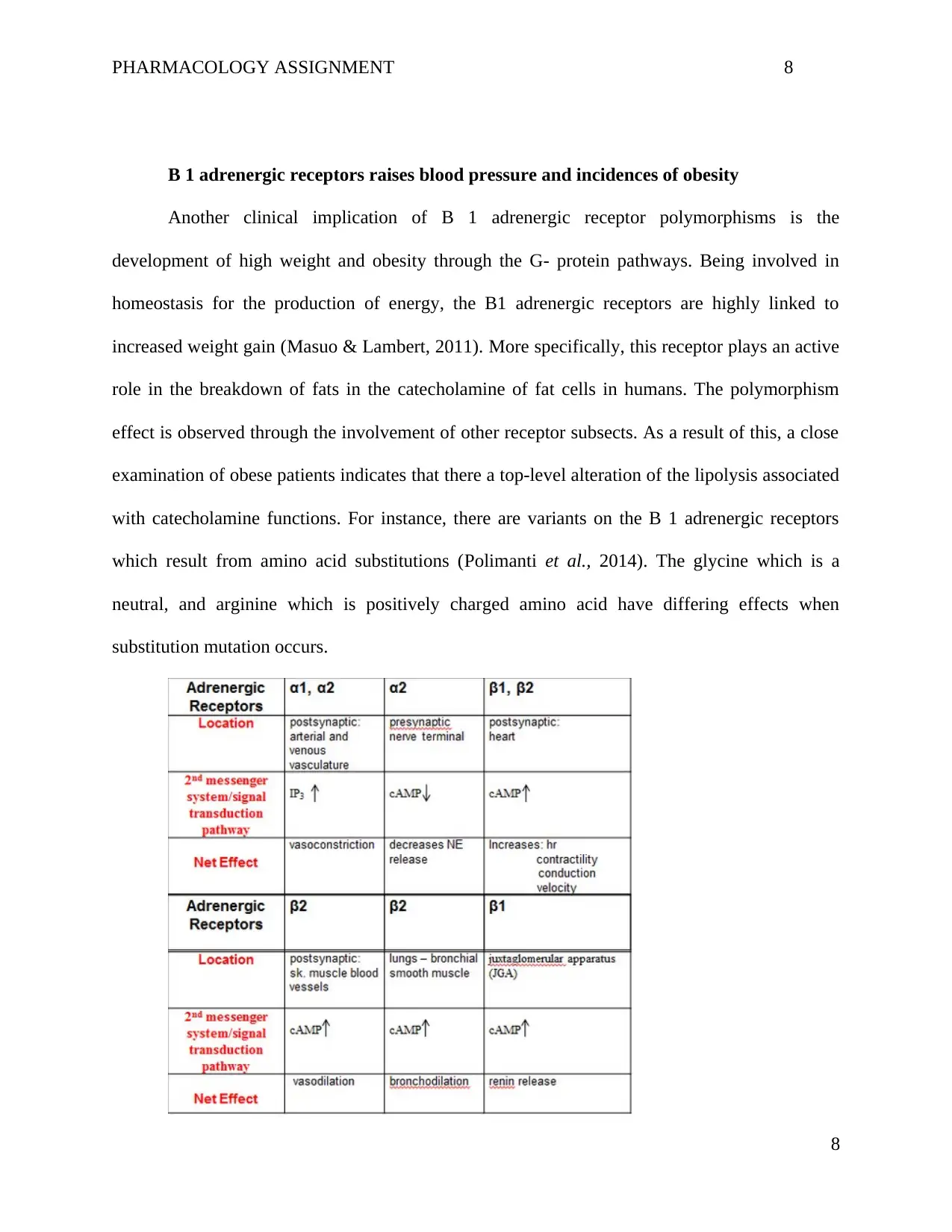
PHARMACOLOGY ASSIGNMENT 8
B 1 adrenergic receptors raises blood pressure and incidences of obesity
Another clinical implication of B 1 adrenergic receptor polymorphisms is the
development of high weight and obesity through the G- protein pathways. Being involved in
homeostasis for the production of energy, the B1 adrenergic receptors are highly linked to
increased weight gain (Masuo & Lambert, 2011). More specifically, this receptor plays an active
role in the breakdown of fats in the catecholamine of fat cells in humans. The polymorphism
effect is observed through the involvement of other receptor subsects. As a result of this, a close
examination of obese patients indicates that there a top-level alteration of the lipolysis associated
with catecholamine functions. For instance, there are variants on the B 1 adrenergic receptors
which result from amino acid substitutions (Polimanti et al., 2014). The glycine which is a
neutral, and arginine which is positively charged amino acid have differing effects when
substitution mutation occurs.
8
B 1 adrenergic receptors raises blood pressure and incidences of obesity
Another clinical implication of B 1 adrenergic receptor polymorphisms is the
development of high weight and obesity through the G- protein pathways. Being involved in
homeostasis for the production of energy, the B1 adrenergic receptors are highly linked to
increased weight gain (Masuo & Lambert, 2011). More specifically, this receptor plays an active
role in the breakdown of fats in the catecholamine of fat cells in humans. The polymorphism
effect is observed through the involvement of other receptor subsects. As a result of this, a close
examination of obese patients indicates that there a top-level alteration of the lipolysis associated
with catecholamine functions. For instance, there are variants on the B 1 adrenergic receptors
which result from amino acid substitutions (Polimanti et al., 2014). The glycine which is a
neutral, and arginine which is positively charged amino acid have differing effects when
substitution mutation occurs.
8
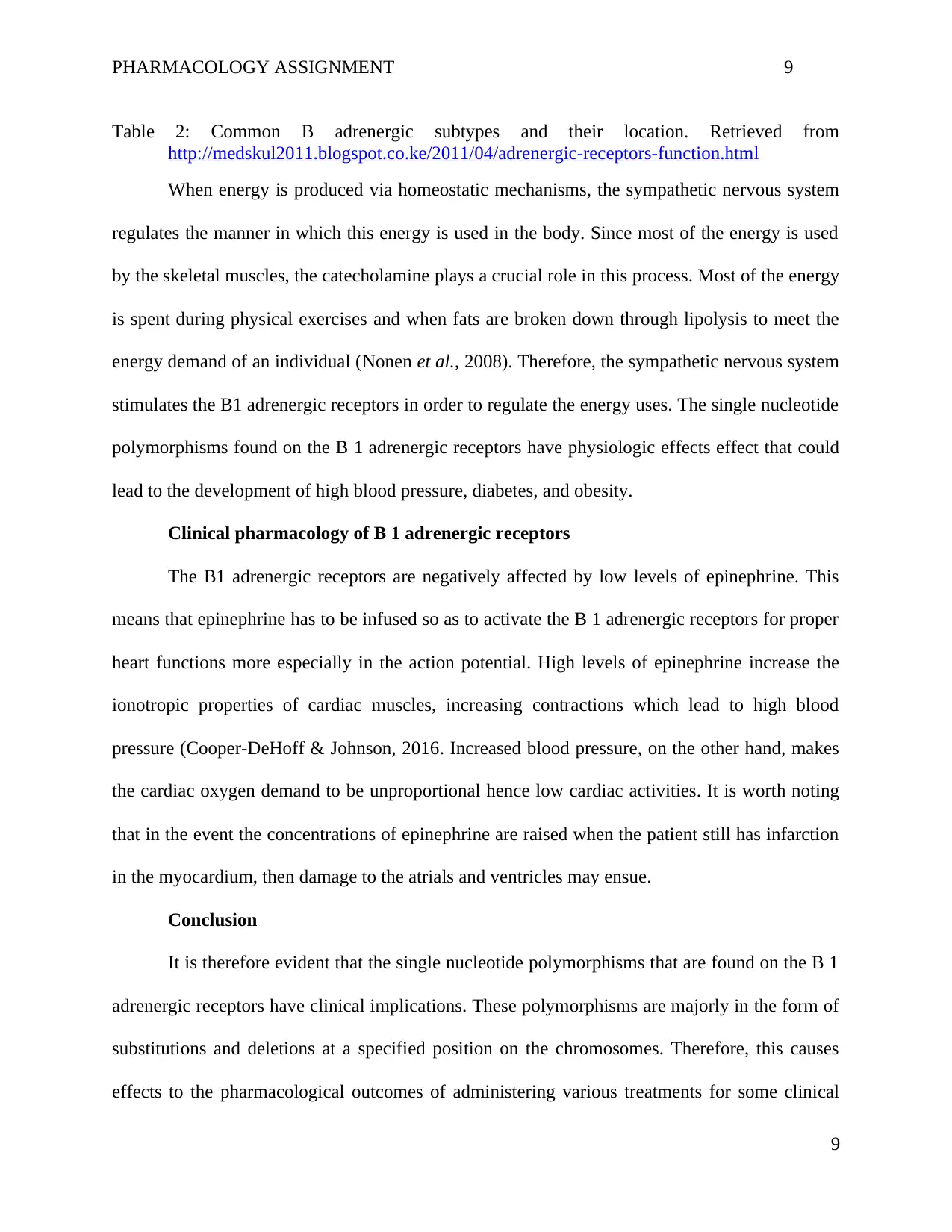
PHARMACOLOGY ASSIGNMENT 9
Table 2: Common B adrenergic subtypes and their location. Retrieved from
http://medskul2011.blogspot.co.ke/2011/04/adrenergic-receptors-function.html
When energy is produced via homeostatic mechanisms, the sympathetic nervous system
regulates the manner in which this energy is used in the body. Since most of the energy is used
by the skeletal muscles, the catecholamine plays a crucial role in this process. Most of the energy
is spent during physical exercises and when fats are broken down through lipolysis to meet the
energy demand of an individual (Nonen et al., 2008). Therefore, the sympathetic nervous system
stimulates the B1 adrenergic receptors in order to regulate the energy uses. The single nucleotide
polymorphisms found on the B 1 adrenergic receptors have physiologic effects effect that could
lead to the development of high blood pressure, diabetes, and obesity.
Clinical pharmacology of B 1 adrenergic receptors
The B1 adrenergic receptors are negatively affected by low levels of epinephrine. This
means that epinephrine has to be infused so as to activate the B 1 adrenergic receptors for proper
heart functions more especially in the action potential. High levels of epinephrine increase the
ionotropic properties of cardiac muscles, increasing contractions which lead to high blood
pressure (Cooper-DeHoff & Johnson, 2016. Increased blood pressure, on the other hand, makes
the cardiac oxygen demand to be unproportional hence low cardiac activities. It is worth noting
that in the event the concentrations of epinephrine are raised when the patient still has infarction
in the myocardium, then damage to the atrials and ventricles may ensue.
Conclusion
It is therefore evident that the single nucleotide polymorphisms that are found on the B 1
adrenergic receptors have clinical implications. These polymorphisms are majorly in the form of
substitutions and deletions at a specified position on the chromosomes. Therefore, this causes
effects to the pharmacological outcomes of administering various treatments for some clinical
9
Table 2: Common B adrenergic subtypes and their location. Retrieved from
http://medskul2011.blogspot.co.ke/2011/04/adrenergic-receptors-function.html
When energy is produced via homeostatic mechanisms, the sympathetic nervous system
regulates the manner in which this energy is used in the body. Since most of the energy is used
by the skeletal muscles, the catecholamine plays a crucial role in this process. Most of the energy
is spent during physical exercises and when fats are broken down through lipolysis to meet the
energy demand of an individual (Nonen et al., 2008). Therefore, the sympathetic nervous system
stimulates the B1 adrenergic receptors in order to regulate the energy uses. The single nucleotide
polymorphisms found on the B 1 adrenergic receptors have physiologic effects effect that could
lead to the development of high blood pressure, diabetes, and obesity.
Clinical pharmacology of B 1 adrenergic receptors
The B1 adrenergic receptors are negatively affected by low levels of epinephrine. This
means that epinephrine has to be infused so as to activate the B 1 adrenergic receptors for proper
heart functions more especially in the action potential. High levels of epinephrine increase the
ionotropic properties of cardiac muscles, increasing contractions which lead to high blood
pressure (Cooper-DeHoff & Johnson, 2016. Increased blood pressure, on the other hand, makes
the cardiac oxygen demand to be unproportional hence low cardiac activities. It is worth noting
that in the event the concentrations of epinephrine are raised when the patient still has infarction
in the myocardium, then damage to the atrials and ventricles may ensue.
Conclusion
It is therefore evident that the single nucleotide polymorphisms that are found on the B 1
adrenergic receptors have clinical implications. These polymorphisms are majorly in the form of
substitutions and deletions at a specified position on the chromosomes. Therefore, this causes
effects to the pharmacological outcomes of administering various treatments for some clinical
9
⊘ This is a preview!⊘
Do you want full access?
Subscribe today to unlock all pages.

Trusted by 1+ million students worldwide
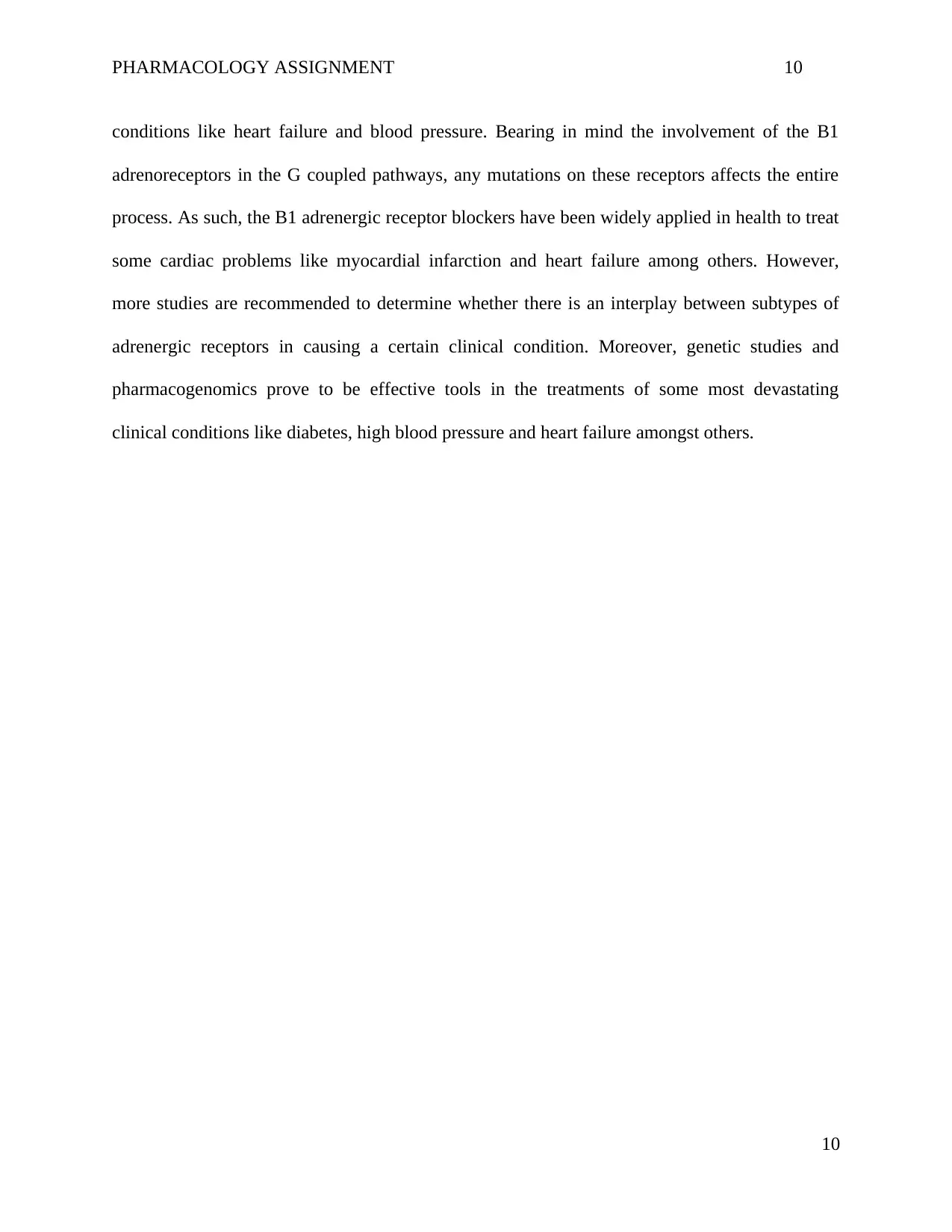
PHARMACOLOGY ASSIGNMENT 10
conditions like heart failure and blood pressure. Bearing in mind the involvement of the B1
adrenoreceptors in the G coupled pathways, any mutations on these receptors affects the entire
process. As such, the B1 adrenergic receptor blockers have been widely applied in health to treat
some cardiac problems like myocardial infarction and heart failure among others. However,
more studies are recommended to determine whether there is an interplay between subtypes of
adrenergic receptors in causing a certain clinical condition. Moreover, genetic studies and
pharmacogenomics prove to be effective tools in the treatments of some most devastating
clinical conditions like diabetes, high blood pressure and heart failure amongst others.
10
conditions like heart failure and blood pressure. Bearing in mind the involvement of the B1
adrenoreceptors in the G coupled pathways, any mutations on these receptors affects the entire
process. As such, the B1 adrenergic receptor blockers have been widely applied in health to treat
some cardiac problems like myocardial infarction and heart failure among others. However,
more studies are recommended to determine whether there is an interplay between subtypes of
adrenergic receptors in causing a certain clinical condition. Moreover, genetic studies and
pharmacogenomics prove to be effective tools in the treatments of some most devastating
clinical conditions like diabetes, high blood pressure and heart failure amongst others.
10
Paraphrase This Document
Need a fresh take? Get an instant paraphrase of this document with our AI Paraphraser
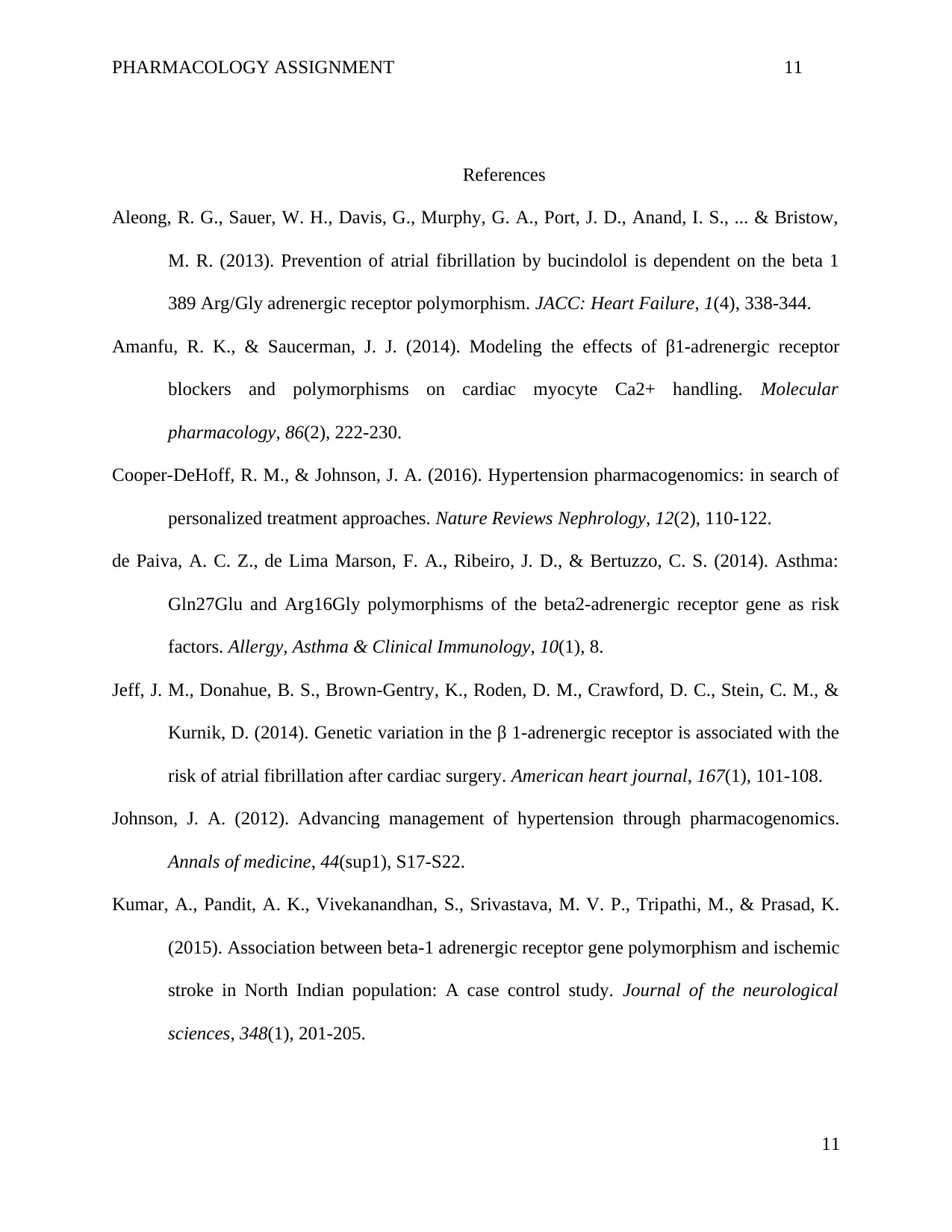
PHARMACOLOGY ASSIGNMENT 11
References
Aleong, R. G., Sauer, W. H., Davis, G., Murphy, G. A., Port, J. D., Anand, I. S., ... & Bristow,
M. R. (2013). Prevention of atrial fibrillation by bucindolol is dependent on the beta 1
389 Arg/Gly adrenergic receptor polymorphism. JACC: Heart Failure, 1(4), 338-344.
Amanfu, R. K., & Saucerman, J. J. (2014). Modeling the effects of β1-adrenergic receptor
blockers and polymorphisms on cardiac myocyte Ca2+ handling. Molecular
pharmacology, 86(2), 222-230.
Cooper-DeHoff, R. M., & Johnson, J. A. (2016). Hypertension pharmacogenomics: in search of
personalized treatment approaches. Nature Reviews Nephrology, 12(2), 110-122.
de Paiva, A. C. Z., de Lima Marson, F. A., Ribeiro, J. D., & Bertuzzo, C. S. (2014). Asthma:
Gln27Glu and Arg16Gly polymorphisms of the beta2-adrenergic receptor gene as risk
factors. Allergy, Asthma & Clinical Immunology, 10(1), 8.
Jeff, J. M., Donahue, B. S., Brown-Gentry, K., Roden, D. M., Crawford, D. C., Stein, C. M., &
Kurnik, D. (2014). Genetic variation in the β 1-adrenergic receptor is associated with the
risk of atrial fibrillation after cardiac surgery. American heart journal, 167(1), 101-108.
Johnson, J. A. (2012). Advancing management of hypertension through pharmacogenomics.
Annals of medicine, 44(sup1), S17-S22.
Kumar, A., Pandit, A. K., Vivekanandhan, S., Srivastava, M. V. P., Tripathi, M., & Prasad, K.
(2015). Association between beta-1 adrenergic receptor gene polymorphism and ischemic
stroke in North Indian population: A case control study. Journal of the neurological
sciences, 348(1), 201-205.
11
References
Aleong, R. G., Sauer, W. H., Davis, G., Murphy, G. A., Port, J. D., Anand, I. S., ... & Bristow,
M. R. (2013). Prevention of atrial fibrillation by bucindolol is dependent on the beta 1
389 Arg/Gly adrenergic receptor polymorphism. JACC: Heart Failure, 1(4), 338-344.
Amanfu, R. K., & Saucerman, J. J. (2014). Modeling the effects of β1-adrenergic receptor
blockers and polymorphisms on cardiac myocyte Ca2+ handling. Molecular
pharmacology, 86(2), 222-230.
Cooper-DeHoff, R. M., & Johnson, J. A. (2016). Hypertension pharmacogenomics: in search of
personalized treatment approaches. Nature Reviews Nephrology, 12(2), 110-122.
de Paiva, A. C. Z., de Lima Marson, F. A., Ribeiro, J. D., & Bertuzzo, C. S. (2014). Asthma:
Gln27Glu and Arg16Gly polymorphisms of the beta2-adrenergic receptor gene as risk
factors. Allergy, Asthma & Clinical Immunology, 10(1), 8.
Jeff, J. M., Donahue, B. S., Brown-Gentry, K., Roden, D. M., Crawford, D. C., Stein, C. M., &
Kurnik, D. (2014). Genetic variation in the β 1-adrenergic receptor is associated with the
risk of atrial fibrillation after cardiac surgery. American heart journal, 167(1), 101-108.
Johnson, J. A. (2012). Advancing management of hypertension through pharmacogenomics.
Annals of medicine, 44(sup1), S17-S22.
Kumar, A., Pandit, A. K., Vivekanandhan, S., Srivastava, M. V. P., Tripathi, M., & Prasad, K.
(2015). Association between beta-1 adrenergic receptor gene polymorphism and ischemic
stroke in North Indian population: A case control study. Journal of the neurological
sciences, 348(1), 201-205.
11

PHARMACOLOGY ASSIGNMENT 12
Lymperopoulos, A., Rengo, G., & Koch, W. J. (2013). Adrenergic nervous system in heart
failure. Circulation research, 113(6), 739-753.
Masuo, K., & Lambert, G. W. (2011). Relationships of adrenoceptor polymorphisms with
obesity. Journal of obesity, 2011.
Nonen, S., Yamamoto, I., Liu, J., Maeda, M., Motomura, T., Igarashi, T., ... & Azuma, J. (2008).
Adrenergic β1 receptor polymorphism (Ser49gly) is associated with obesity in type II
diabetic patients. Biological and Pharmaceutical Bulletin, 31(2), 295-298.
Polimanti, R., Iorio, A., Piacentini, S., Manfellotto, D., & Fuciarelli, M. (2014). Human
pharmacogenomic variation of antihypertensive drugs: from population genetics to
personalized medicine. Pharmacogenomics, 15(2), 157-167.
Zanolla, L., Guarise, P., Tomasi, L., Vassanelli, C., Cicorella, N., Zanini, R., ... & Matullo, G.
(2016). Association between Beta1‐Adrenergic Receptor Polymorphism and Risk of ICD
Shock in Heart Failure Patients. Pacing and Clinical Electrophysiology, 39(6), 557-564.
12
Lymperopoulos, A., Rengo, G., & Koch, W. J. (2013). Adrenergic nervous system in heart
failure. Circulation research, 113(6), 739-753.
Masuo, K., & Lambert, G. W. (2011). Relationships of adrenoceptor polymorphisms with
obesity. Journal of obesity, 2011.
Nonen, S., Yamamoto, I., Liu, J., Maeda, M., Motomura, T., Igarashi, T., ... & Azuma, J. (2008).
Adrenergic β1 receptor polymorphism (Ser49gly) is associated with obesity in type II
diabetic patients. Biological and Pharmaceutical Bulletin, 31(2), 295-298.
Polimanti, R., Iorio, A., Piacentini, S., Manfellotto, D., & Fuciarelli, M. (2014). Human
pharmacogenomic variation of antihypertensive drugs: from population genetics to
personalized medicine. Pharmacogenomics, 15(2), 157-167.
Zanolla, L., Guarise, P., Tomasi, L., Vassanelli, C., Cicorella, N., Zanini, R., ... & Matullo, G.
(2016). Association between Beta1‐Adrenergic Receptor Polymorphism and Risk of ICD
Shock in Heart Failure Patients. Pacing and Clinical Electrophysiology, 39(6), 557-564.
12
⊘ This is a preview!⊘
Do you want full access?
Subscribe today to unlock all pages.

Trusted by 1+ million students worldwide
1 out of 12
Your All-in-One AI-Powered Toolkit for Academic Success.
+13062052269
info@desklib.com
Available 24*7 on WhatsApp / Email
![[object Object]](/_next/static/media/star-bottom.7253800d.svg)
Unlock your academic potential
Copyright © 2020–2025 A2Z Services. All Rights Reserved. Developed and managed by ZUCOL.
